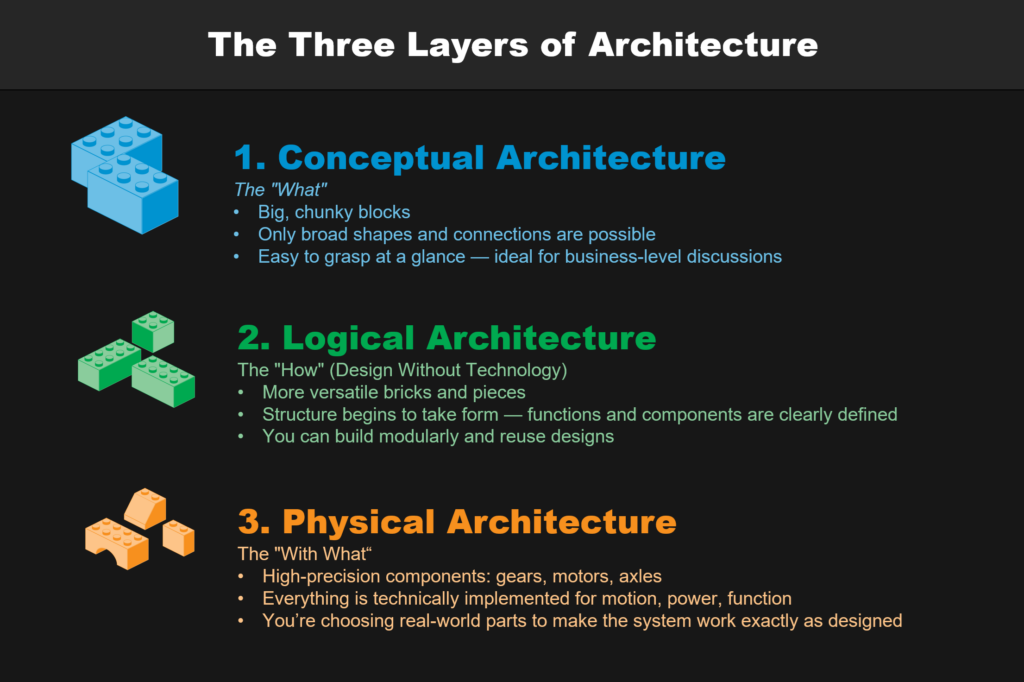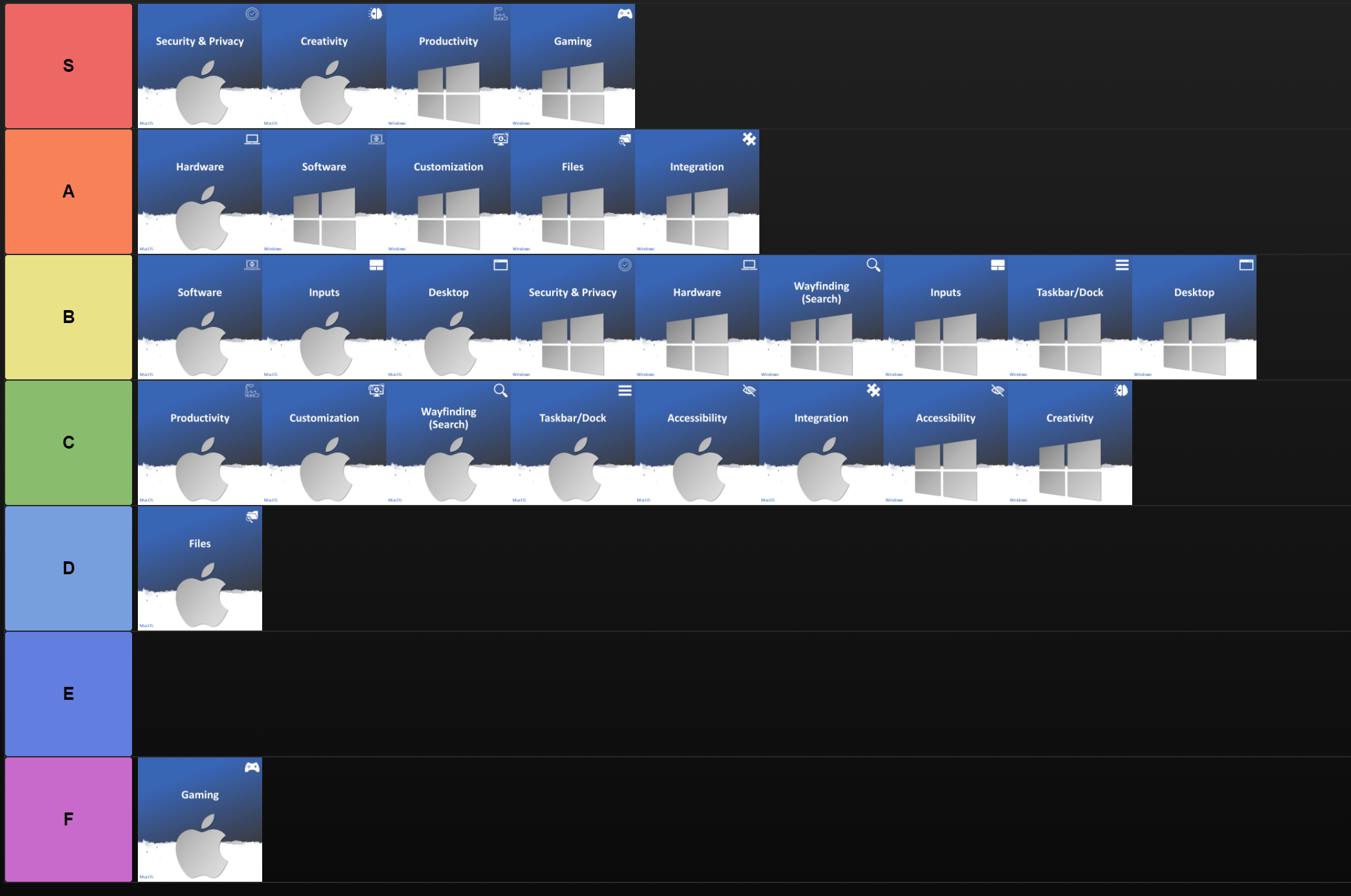If you’ve ever built something out of LEGO—from a simple tower to a functioning machine—you already understand the essence of IT Architecture.
Modern systems aren’t built all at once. They evolve in structured layers, progressing from broad ideas to detailed implementation. In IT architecture, this layered thinking is broken down into three core levels: Conceptual, Logical, and Physical.
In this post, we’ll explore these architectural layers through a familiar metaphor: LEGO. From Duplo to Technic, each type of LEGO brick helps us illustrate how IT systems go from vision to reality.
Why Architecture Layers Matter
Too often, technology decisions are made without fully understanding the business context or system design. This leads to fragmented systems, duplicated functionality, or worse—projects that never deliver value.
Layered architecture helps avoid this. It ensures that we:
- Understand the business problem first
- Design flexible and scalable structures
- Implement with the right tools and technologies
Each layer serves a different purpose, with a different audience and level of detail:
| Layer | Focus | Audience | Level of Detail |
|---|---|---|---|
| Conceptual | What the system does | Business, Enterprise Arch. | High-level (abstract) |
| Logical | How it’s organized logically | Solution Arch., Analysts | Mid-level (tech-agnostic) |
| Physical | How it’s built and deployed | Developers, DevOps | Detailed (tech-specific) |
Understanding where you are in this structure—and who you’re designing for—can save time, reduce complexity, and improve communication across teams.

Let’s look at how each architectural layer plays a role, using LEGO as our guide.
Conceptual Architecture – The Duplo Layer
At the conceptual level, we focus on the big picture: what the system is supposed to do and why it exists.
This is where Duplo blocks come in. These large, simple bricks represent high-level ideas. They’re easy to work with and perfect for quickly sketching out major components without getting lost in detail.
In IT terms, this layer might define:
- Business capabilities or domains (e.g., Order Management, Customer Engagement)
- High-level user goals or value streams
- The relationships between key areas of the system
Example:
We need a digital commerce platform that includes a customer portal, product catalog, and order processing.
This layer is ideal for conversations with business stakeholders, product owners, and enterprise architects. It ensures alignment on scope and purpose before moving into design.
Logical Architecture – The LEGO Layer
Once the conceptual layer is clear, we move to the logical architecture. This is where standard LEGO bricks come into play.
Here, we define how the system will be structured. This includes:
- Functional components and modules
- Service boundaries and responsibilities
- Data flow and interaction patterns
The logical layer is still technology-agnostic. We’re not choosing cloud providers or coding languages yet. Instead, we’re designing structure and behavior.
Example:
The order processing service will communicate with inventory and billing services via APIs. The customer portal will use a separate authentication service and interact with the cart and checkout modules.
This layer is essential for solution architects, system designers, and technical leads who need to define a scalable and maintainable system without locking into specific tools too early.
Physical Architecture – The Technic Layer
Finally, the physical architecture defines how the system will be implemented using real-world technologies and infrastructure.
This is where LEGO Technic fits in. These advanced components—gears, motors, connectors—let you build working machines. Similarly, physical architecture decisions involve:
- Technology stacks and frameworks
- Deployment models (e.g., containers, cloud platforms)
- Security, performance, and operational considerations
Example:
The order service is implemented in .NET Core, deployed via Docker on Azure Kubernetes Service. The frontend is built with React and hosted on a static web app with CDN integration.
This is the layer where developers, DevOps engineers, and infrastructure architects make everything come to life. It’s also where performance, monitoring, and scaling become critical concerns.
Why the LEGO Metaphor Works
The LEGO metaphor isn’t just playful—it’s practical. It reflects the modular, layered, and iterative nature of good system design. Just like with LEGO:
- You can build simple prototypes before committing to complex builds.
- You can swap out components without redesigning everything.
- You can scale from proof-of-concept to enterprise solution using the same core principles.
It also reminds us that each layer has its own purpose and audience. Skipping straight to implementation without clear conceptual or logical foundations is like building a Technic model without instructions or design.
Common Pitfalls
| Problem | How Layered Thinking Helps |
|---|---|
| Starting with tools and tech | Ensures business goals are defined first |
| Inflexible or brittle systems | Encourages modular, reusable design |
| Misalignment between teams | Provides a common language across roles |
Final Thoughts
What we build matters—but how we build it often matters more. In a world filled with frameworks, cloud providers, and architectural trends, it’s easy to lose sight of the fundamentals.
Returning to the simplicity of LEGO—Duplo, LEGO, Technic—reminds us that structure, intention, and progression are the real building blocks of resilient systems.
So the next time you’re looking at a whiteboard sketch or a deployment diagram, ask yourself:
Are we still building with Duplo? Are we ready for Technic?
Good architecture doesn’t just scale systems—it scales thinking.
LEGO®, DUPLO®, and Technic™ are trademarks of the LEGO Group, which does not sponsor, authorize, or endorse this content.
